Themed collection Systems Chemistry

Systems chemistry: a web themed issue
Investigating mixtures of molecules that exhibit emergent properties – this themed issue includes studies from all aspects of systems chemistry. Our guest editors, Douglas Philp, Sijbren Otto and Bartosz Grzybowski have gathered a collection of papers to demonstrate the importance of this emerging field of research.

Chem. Commun., 2014,50, 14924-14925
https://doi.org/10.1039/C4CC90422B
Coupled chemical oscillators and emergent system properties
We review recent work on a variety of systems, from the nanometre to the centimetre scale, including microemulsions, microfluidic droplet arrays, gels and flow reactors, in which chemical oscillators interact to generate novel spatiotemporal patterns and/or mechanical motion.
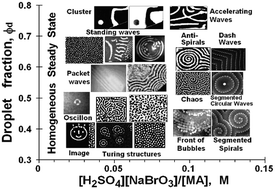
Chem. Commun., 2014,50, 10758-10767
https://doi.org/10.1039/C4CC00290C
Emergent properties arising from the assembly of amphiphiles. Artificial vesicle membranes as reaction promoters and regulators
Membranes of artificial vesicles may act as reaction promoters and regulators.
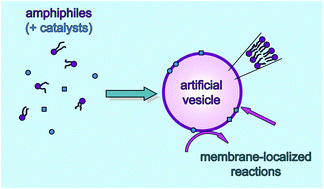
Chem. Commun., 2014,50, 10177-10197
https://doi.org/10.1039/C4CC02812K
Energy propagation throughout chemical networks
Fluxes of energy through cascades of reaction–diffusion cycles can sustain matter fluxes between spatially and chemically segregated zones.
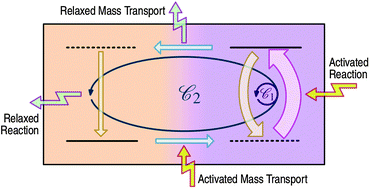
Chem. Commun., 2014,50, 6189-6195
https://doi.org/10.1039/C4CC00392F
Probing secondary interactions in biomolecular recognition by dynamic combinatorial chemistry
The implementation of dynamic combinatorial chemistry enables identification of multi-point binding ligands and receptors of biomolecules by a one-pot screening of secondary interactions.
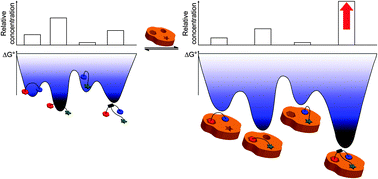
Chem. Commun., 2014,50, 5810-5825
https://doi.org/10.1039/C4CC00263F
A bistable switch in pH in urease-loaded alginate beads
A bistable switch from a low pH (unreacted “off”) state to a high pH (reacted “on”) state was obtained in enzyme-loaded gel beads in response to supra-threshold substrate concentrations.
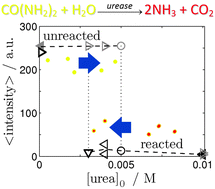
Chem. Commun., 2014,50, 11107-11109
https://doi.org/10.1039/C4CC03936J
Four acid-catalysed dehydration reactions proceed without interference
Four acid-catalysed dehydration reactions can proceed in one pot, simultaneously and without interference, to yield one imine, one acetal (or boronic ester), one ester and one alkene, even though many other cross-products could be conceived.
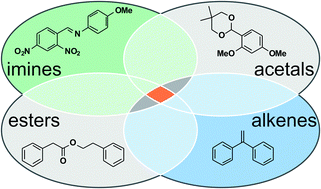
Chem. Commun., 2014,50, 9401-9404
https://doi.org/10.1039/C4CC02990A
Transmission of photo-catalytic function in a self-replicating chemical system: in situ amphiphile production over two protocell generations
The transmission of a protocell catalytic function during self-replication was demonstrated using a glass microsphere-supported protocell design.
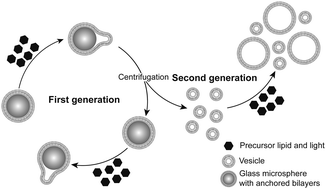
Chem. Commun., 2014,50, 8989-8992
https://doi.org/10.1039/C4CC01543F
Interfacial mass transfer by controlled multilayer disassembly
We demonstrated the one-pot disassembly of self-propagating molecular assemblies (SPMAs) by ligand exchange and the subsequent covalent binding of the molecular components to other surfaces.
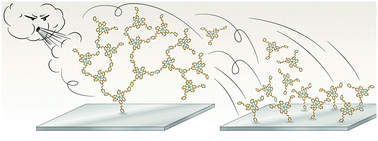
Chem. Commun., 2014,50, 8154-8156
https://doi.org/10.1039/C4CC00495G
Simulation of the self-assembly of simple molecular bricks into Sierpiński triangles
Monte Carlo simulations reveal the surface-confined self-assembly of simple organic ligands (orange) and metal atoms (blue) into hierarchical fractal structures resembling the Sierpiński triangle.
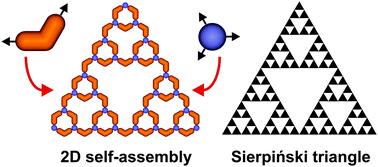
Chem. Commun., 2014,50, 6843-6845
https://doi.org/10.1039/C4CC01344A
Introducing charge transfer functionality into prebiotically relevant β-sheet peptide fibrils
Amphiphilic peptide possessing non-natural aromatic groups forms fibrils consisting long range π-stacking interactions. Being similar to previously studied replicator the peptide is suggested as future component in functional self-synthesizing materials.
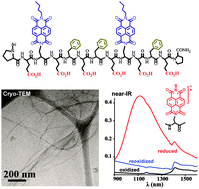
Chem. Commun., 2014,50, 6733-6736
https://doi.org/10.1039/C4CC00717D
Diffusive fingering in a precipitation reaction driven by autocatalysis
The interaction of an autocatalytic reaction with a fast precipitation reaction produces a permanent pattern with precipitate-free zones.

Chem. Commun., 2014,50, 5580-5582
https://doi.org/10.1039/C4CC00142G
Biocatalytic amide condensation and gelation controlled by light
We report on a supramolecular self-assembly system that displays coupled light switching, biocatalytic condensation/hydrolysis and gelation.
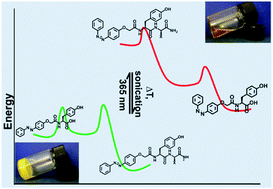
Chem. Commun., 2014,50, 5462-5464
https://doi.org/10.1039/C4CC01431F
Constitutional self-selection from dynamic combinatorial libraries in aqueous solution through supramolecular interactions
Cooperative supramolecular interactions induce the formation of a major constitution from topologically diverse dynamic combinatorial libraries of pseudopeptides in aqueous solution.
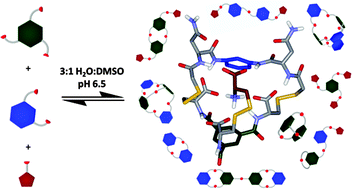
Chem. Commun., 2014,50, 4564-4566
https://doi.org/10.1039/C4CC00245H
Self-organization of calcium oxalate by flow-driven precipitation
In the calcium-oxalate system fast kinetics with flow leads to the enrichment of the thermodynamically unstable dihydrate crystalline form.

Chem. Commun., 2014,50, 4289-4291
https://doi.org/10.1039/C4CC00205A
Generation of spatiotemporal calcium patterns by coupling a pH-oscillator to a complexation equilibrium
Calcium waves and patterns have been observed in the bromate–sulfite–ferrocyanide–CaEDTA reaction–diffusion system, where pH-oscillations drive binding and release of calcium ions.
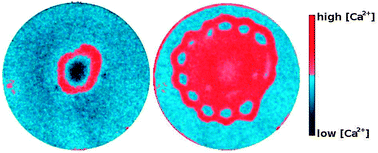
Chem. Commun., 2014,50, 4158-4160
https://doi.org/10.1039/C4CC00199K
Model identification of a template-directed peptide network for optimization in a continuous reactor
With an open driven system, the chemical network can be controlled to new nonequilibrium steady states.
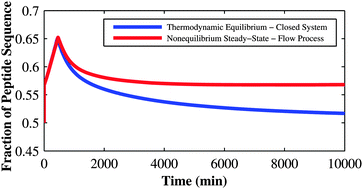
Chem. Commun., 2014,50, 3849-3851
https://doi.org/10.1039/C4CC00501E
Silver-catalyzed dynamic systemic resolution of α-iminonitriles in a 1,3-dipolar cycloaddition process
A silver-catalyzed dynamic azomethine ylide system was kinetically resolved in a tandem cycloaddition process, yielding an exclusive pyrrolidine product.

Chem. Commun., 2014,50, 3792-3794
https://doi.org/10.1039/C4CC00944D
Diastereoselectivity in prebiotically relevant 5(4H)-oxazolone-mediated peptide couplings
Although usually considered to be harmful in peptide couplings, 5(4H)-oxazolones could also contribute to chiral enhancement in racemic mixtures.
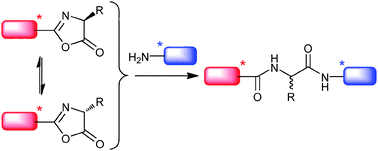
Chem. Commun., 2014,50, 3100-3102
https://doi.org/10.1039/C3CC49580A
Self-sorting of dynamic metallosupramolecular libraries (DMLs) via metal-driven selection
“Metal-driven” selection between finite mononuclear and polymeric metallosupramolecular species can be quantitatively achieved.
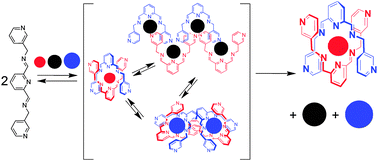
Chem. Commun., 2014,50, 2621-2623
https://doi.org/10.1039/C3CC49673B
About this collection
Investigating mixtures of molecules that exhibit emergent properties – this themed issue includes studies from all aspects of systems chemistry. Our guest editors, Douglas Philp, Sijbren Otto and Bartosz Grzybowski have gathered a collection of papers to demonstrate the importance of this emerging field of research.